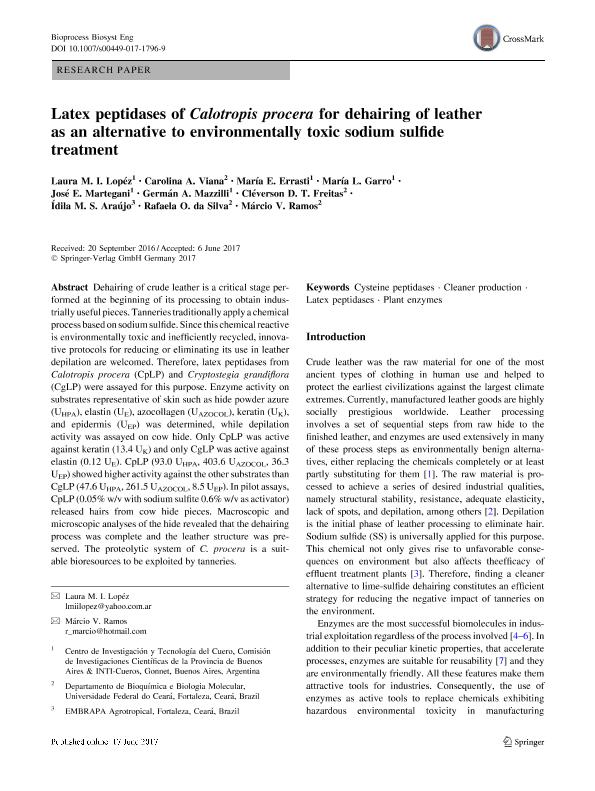Artículo
Latex peptidases of Calotropis procera for dehairing of leather as an alternative to environmentally toxic sodium sulfide treatment
Lopez, Laura Maria Isabel ; Viana, Carolina A.; Errasti, María Eugenia
; Viana, Carolina A.; Errasti, María Eugenia ; Garro, María Laura; Martegani, José Eduardo; Mazzilli, German Ariel; Freitas, Cléverson D. T.; Araújo, Ídila M. S.; da Silva, Rafaela O.; Ramos, Márcio V.
; Garro, María Laura; Martegani, José Eduardo; Mazzilli, German Ariel; Freitas, Cléverson D. T.; Araújo, Ídila M. S.; da Silva, Rafaela O.; Ramos, Márcio V.
 ; Viana, Carolina A.; Errasti, María Eugenia
; Viana, Carolina A.; Errasti, María Eugenia ; Garro, María Laura; Martegani, José Eduardo; Mazzilli, German Ariel; Freitas, Cléverson D. T.; Araújo, Ídila M. S.; da Silva, Rafaela O.; Ramos, Márcio V.
; Garro, María Laura; Martegani, José Eduardo; Mazzilli, German Ariel; Freitas, Cléverson D. T.; Araújo, Ídila M. S.; da Silva, Rafaela O.; Ramos, Márcio V.
Fecha de publicación:
06/2017
Editorial:
Springer
Revista:
Bioprocess And Biosystems Engineering
ISSN:
1615-7591
Idioma:
Inglés
Tipo de recurso:
Artículo publicado
Clasificación temática:
Resumen
Dehairing of crude leather is a critical stage performed at the beginning of its processing to obtain industrially useful pieces. Tanneries traditionally apply a chemical process based on sodium sulfide. Since this chemical reactive is environmentally toxic and inefficiently recycled, innovative protocols for reducing or eliminating its use in leather depilation are welcomed. Therefore, latex peptidases from Calotropis procera (CpLP) and Cryptostegia grandiflora (CgLP) were assayed for this purpose. Enzyme activity on substrates representative of skin such as hide powder azure (UHPA), elastin (UE), azocollagen (UAZOCOL), keratin (UK), and epidermis (UEP) was determined, while depilation activity was assayed on cow hide. Only CpLP was active against keratin (13.4 UK) and only CgLP was active against elastin (0.12 UE). CpLP (93.0 UHPA, 403.6 UAZOCOL, 36.3 UEP) showed higher activity against the other substrates than CgLP (47.6 UHPA, 261.5 UAZOCOL, 8.5 UEP). In pilot assays, CpLP (0.05% w/v with sodium sulfite 0.6% w/v as activator) released hairs from cow hide pieces. Macroscopic and microscopic analyses of the hide revealed that the dehairing process was complete and the leather structure was preserved. The proteolytic system of C. procera is a suitable bioresources to be exploited by tanneries.
Palabras clave:
Cleaner Production
,
Cysteine Peptidases
,
Latex Peptidases
,
Plant Enzymes
Archivos asociados
Licencia
Identificadores
Colecciones
Articulos(CCT - LA PLATA)
Articulos de CTRO.CIENTIFICO TECNOL.CONICET - LA PLATA
Articulos de CTRO.CIENTIFICO TECNOL.CONICET - LA PLATA
Citación
Lopez, Laura Maria Isabel; Viana, Carolina A.; Errasti, María Eugenia; Garro, María Laura; Martegani, José Eduardo; et al.; Latex peptidases of Calotropis procera for dehairing of leather as an alternative to environmentally toxic sodium sulfide treatment; Springer; Bioprocess And Biosystems Engineering; 40; 9; 6-2017; 1391-1398
Compartir
Altmétricas



